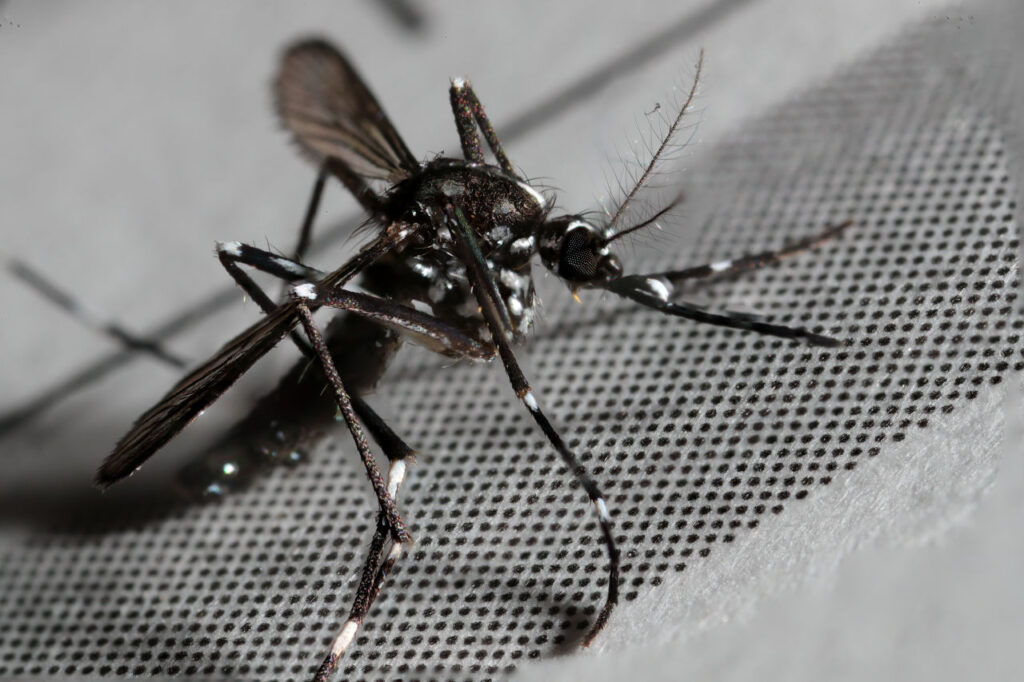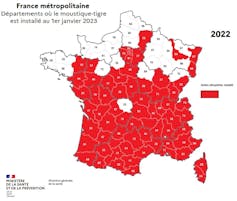Dengue virus in mainland France: what can we expect this year?
Vacations don't always go as planned... In our series "A week in hell!", we decipher what can go wrong, from motion sickness amplified during vacation departures to mosquito bites now capable of transmitting tropical viruses, not to mention the little-known microbiological dangers of hotels, "traditional" sunburn, or the unsuspected dangers... of gardening, if you thought you were staying at home.
Yannick Simonin, University of Montpellier

All the specialists agree that 2022 was an exceptional year in mainland France for the circulation of arboviruses, viruses transmitted by blood-feeding arthropods such as ticks and mosquitoes.
Is this year a harbinger of things to come? Or is it more of an anomaly for our country, which usually has very little experience of these viruses, which are considered more "exotic"?
2022, a record-breaking year in mainland France
Flashback. In mid-summer 2022, the first "autochthonous" case of dengue transmission was reported in France. This adjective describes an infection detected on French territory, without the patient having previously traveled to a contaminated zone. Unlike cases "imported" from abroad, this means that the virus is circulating in the country.
This was hardly surprising: dengue fever, the world's most widespread arboviral disease, which affects between 100 and 400 million people every year, has already been responsible for native cases in mainland France in recent years. In particular, the virus has been detected in the Alpes Maritimes, Var, Bouches du Rhône, Hérault and Gard departments, accounting for some 30 cases since 2010. Nothing to worry about initially, then.
But then 2022 didn't go as planned, and one autochthonous case followed another. Nine episodes of autochthonous dengue transmission were recorded, totalling 66 cases, in the regions of Occitanie (12 cases), Provence-Alpes-Côte d'Azur (52 cases) and Corsica (two cases). The virus also affected new départements in which no case of dengue had ever been identified, such as Haute-Garonne, Hautes-Pyrénées and Pyrénées-Orientales.
66 autochthonous cases may not seem like a lot, but in just one year, this represents more than double the number of cases recorded in the 12 years since the first case of autochthonous dengue fever was identified in France in 2010 in the Alpes Maritimes.
But dengue fever is not a disease to be taken lightly.
Dengue, a potentially serious disease
While dengue is asymptomatic in a large proportion of cases (50% to 90%, depending on the study), in around 1% of cases it can lead to a potentially fatal form of the disease: so-called "hemorrhagic" dengue, which is accompanied by multiple bleeding episodes, notably in the gastrointestinal tract, skin and brain.
[More than 85,000 readers trust The Conversation newsletters to help them better understand the world's major issues. Subscribe today]
In other symptomatic people, the disease mainly manifests itself through symptoms similar to those of the flu: fever, headaches, muscle aches... It is estimated that every year, 500,000 people worldwide are hospitalized for severe forms of the disease, resulting in between 10,000 and 15,000 deaths. In addition to the cost in human lives, the management of the disease has a definite cost for the community.
Limiting the number of cases is important, as the disease can spread with every mosquito bite.

How can we fight?
When a mosquito vector bites an infected host, the virus multiplies in the host's body. On the next bite, it passes into the bloodstream of another person, where it can be picked up by another mosquito, and so on.
The best way to limit the spread of infection is therefore to combat the virus' main vector: Aedes albopictus, better known as the tiger mosquito.
This is a very complicated task, as the mosquito's range has continued to expand in France in recent years, significantly increasing the number of departments at risk.
Each identified outbreak requires a fairly extensive infrastructure to be put in place to break the cycle of virus circulation in the human population: mosquito control operations in the vicinity of detected cases (to eliminate adult mosquitoes and their larvae), awareness-raising campaigns aimed at the public and healthcare professionals, and door-to-door surveys carried out in collaboration with Regional Health Agencies (ARS), Santé publique France and mosquito control agencies (Altopictus or the Entente interdépartementale de démoustication).
What can we expect in the years ahead?
It is very difficult to anticipate the circulation of arboviruses, as their transmission cycle is influenced by multiple parameters.
So it's hard to know whether 2023 and beyond will be like, or worse than, 2022. It's also hard to predict which arbovirosis, between dengue, Zika or chikungunya, will take center stage. As dengue is the most common arbovirosis worldwide, there is nevertheless a strong likelihood of seeing more and more cases of this disease in mainland France in the years to come.
One thing is certain: it is now clearly established that we can expect an increase in cases of arboviral transmission in mainland France over the coming summers. All the more so as the exceptional situation observed in France last year is not an isolated case worldwide.
In the Americas, 2.8 million cases of dengue fever have been identified in 2022, more than double the number of cases reported in 2021. And for some countries, 2023 is already synonymous with an unprecedented dengue epidemic: Peru is suffering the most intense wave since the disease reappeared in the country in 1990.
Another worrying indicator is that the World Health Organization is preparing for the likelihood that the El Niño phenomenon, forecast for 2023 and 2024, could increase the transmission not only of dengue fever, but also of other arboviruses.
Finally, climate change will also have an impact on the proliferation of the mosquitoes that carry these diseases, by lengthening the period of mosquito activity, which currently peaks between May and September. In addition, high temperatures favor the multiplication of viruses in mosquitoes, and hence their transmission.
Monitoring networks at the limits of their capacity
Although an absolute record, the number of dengue cases recorded in 2022 is therefore likely to remain very limited compared to what we can expect in the years to come. What's more, France will be hosting major sporting events over the next few years, including the Olympic Games in 2024, which could contribute to reinforcing the dynamics of arbovirus circulation...
Faced with the emergence of these arboviral diseases, France has set up active surveillance networks. These networks bring together experts with a wide range of skills (veterinarians, clinicians, entomologists, researchers), all of whom contribute to a better understanding of these viruses.
However, last year's explosion in the number of cases has put them to the test locally, as have mosquito control networks, which are operating at the limits of their capacity. This situation highlights the need for further investment in these areas. We need to start preparing now, so as to be in the best possible position to control future epidemics. In this sense, 2022 is a warning that we must all take seriously...
Yannick Simonin, Virologist specializing in the monitoring and study of emerging viral diseases. University Professor, University of Montpellier
This article is republished from The Conversation under a Creative Commons license. Read theoriginal article.